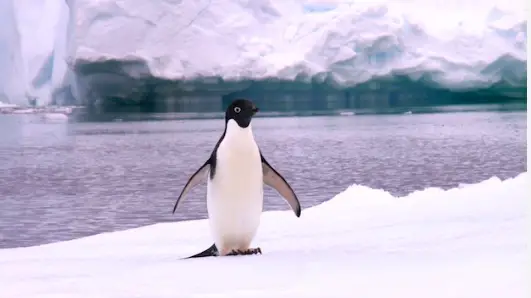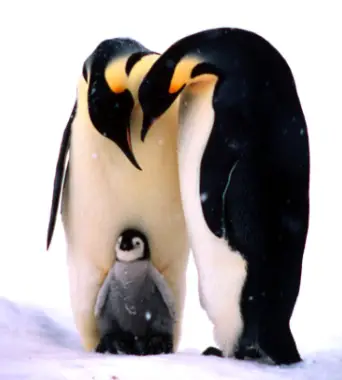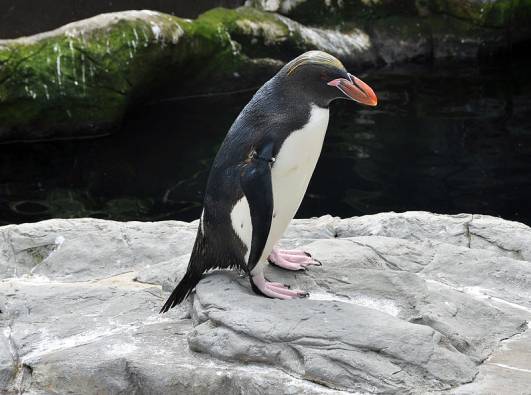By the third day you should be far south enough to see two different kinds of penguins - the Adelie and the Emperor. Worldwide there are only 17 species of penguins and they’re all found in the southern hemisphere, but the Adelie and Emperor are two out of four that actually live and nest on the Antarctic continent.

The Adelie Penguin ((latin name Pygoscelis Adeliae) is the smallest of the Antarctic penguins growing up to about 30 inches, with an average one weighing in at 10 lbs. They have a white ring round their eyes and the end of their bill is red. They look like little fat waiters wearing tuxedos!
Don’t let the apparently slow ‘penguin waddle’ fool you - these birds (yes they are!) can walk long distances at a steady pace of about 1.5 miles an hour. Sometimes to save energy they ‘toboggan’ on their fronts.....And you thought they were just having fun! Have a look at them on this video!
They may look ungainly on land but in the water Adelie penguins are sleek and efficient swimmers. Great divers too - they can dive to a depth of 575 feet to get food - mostly krill, silverfish and squid.
When the breeding season starts (about Oct) the male collects pebbles and begins to build the nest. Usually the female lays 2 eggs and both parents take turn incubating them until they hatch. Although these penguins are generally very sociable and get on with others, they build their nests 2 pecks distance from each other - and it’s not unknown for them to steal nests too. After the chicks are about 4 weeks old they go to a ‘penguin creche’ where they stay until they are able to swim independently - then they are off and running (well swimming!)
Although at the moment the Adelie penguin population seems to be fairly stable - maybe even increasing - it’s true to say that climate change will impact on their environment and they will be much more at risk.
If you’re wondering why it’s called an Adelie penguin - it’s named after the wife of the French Antarctic explorer Dumont d’Urville - and her name was Adele. I hope she thought it was an honour to have such a lovely creature named after her!
From the smallest to the biggest - the second penguin you will certainly want to see is the Emperor penguin (Aptenodytes Forsteri)

Some grow as tall as four feet and can weigh up to 99 lb. They never leave Antarctica and breed in some of the coldest conditions on earth. They’ve specially adapted to this by having 4 layers of feathers which keep out the bitter winds and wet. Their bodies store a lot of fat which helps them warm and give them energy - they actually recycle their own body heat - clever things!
Like the Adelie penguin, on land they look awkward and waddle, so they also slide on their bellies to speed up their journey!
Unlike other penguins Emperors do not build nests, but incubate the eggs using their warm bodies. The females lay just one egg and after about nine weeks she hands the egg over to the male and he takes over. It’s an amazing sight to see the male penguins huddling together - keeping the eggs balanced on their feet and covering it with layers of feathers. Here is a video which shows what very special dads Emperor penguins make.
For two to three months the male can’t eat and has to wait till the female returns to let him go and find food - his reserves are nearly gone - but still he waits. The most amazing things is how all the males work together to support each other- taking it in turn to go to the middle of the pack where it is warmer.
Emperor penguins live on average about 15 - 20 years, however some have been known to live for as long as 40 years. The species is now considered ‘at risk’ because of the activity of humans and the threat of global warming. It would be such a loss if these wonderful animals decline. I hope you agree!


